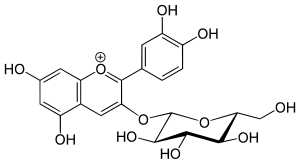Chrysanthemin
 | |
| Names | |
|---|---|
| IUPAC name
(2S,3R,4S,5S,6R)-2-[2-(3,4-dihydroxyphenyl)-5,7-dihydroxychromenylium-3-yl]oxy-6-(hydroxymethyl)oxane-3,4,5-triol chloride | |
| Other names
Chrysontenin Glucocyanidin Asterin Chrysanthemin Purple corn color Kuromanin Kuromanin chloride Cyanidin 3-glucoside Cyanidol 3-glucoside Cyanidine 3-glucoside Cyanidin 3-O-glucoside cyanidin-3-O-beta-D-glucoside Cyanidin 3-monoglucoside C3G | |
| Identifiers | |
| 7084-24-4 | |
| 3D model (Jmol) | Interactive image |
| ChemSpider | 170681 |
| ECHA InfoCard | 100.027.622 |
| PubChem | 197081 |
| |
| |
| Properties | |
| C21H21O11+, Cl− C21H21ClO11 | |
| Molar mass | 484.83 g/mol (chloride) 449.38 g/mol |
| Except where otherwise noted, data are given for materials in their standard state (at 25 °C [77 °F], 100 kPa). | |
| | |
| Infobox references | |
Chrysanthemin is an anthocyanin. It is the 3-glucoside of cyanidin.
Natural occurrences
Chrysanthemin can be found in the roselle plant (Hibiscus sabdariffa, Malvaceae), different Japanese angiosperms,[1] Rhaponticum (Asteraceae),[2] The fruits of the smooth arrowwood (Viburnum dentatum, Caprifoliaceae) appear blue. One of the major pigments is cyanidin 3-glucoside, but the total mixture is very complex.[3]
In food
Chrysanthemin has been detected in blackcurrant pomace, in European elderberry,[4] in red raspberries, in soybean seed coats,[5] in victoria plum,[6] in peach,[7] lychee and açaí.[8] It is found in red oranges[9] and black rice.[10]
It is the major anthocyanin in purple corn (Zea mays). Purple corn is approved in Japan and listed in the "Existing Food Additive List" as purple corn color.[11]
Biosynthesis
The biosynthesis of cyanidin 3-O-glucoside in Escherichia coli was demonstrated by mean of metabolic genetic engineering.[12]
In Arabidopsis thaliana, a glycosyltransferase, UGT79B1, is involved in the anthocyanin biosynthetic pathway. UGT79B1 protein converts cyanidin 3-O-glucoside to cyanidin 3-O-xylosyl(1→2)glucoside.[13]
References
- ↑ "A survey of anthocyanins in sprouting leaves of some Japanese angiosperms studies on anthocyanins, LXV". Kunijiro Yoshitama, Makiko Ozaku, Michiko Hujii and Kôzô Hayashi, Journal of plant research, Volume 85, Number 4, pages 303–306, doi:10.1007/BF02490176
- ↑ "Chrysanthemin and cyanin in species of the genus Rhaponticum. V. V. Vereskovskii and I. I. Chekalinskaya, Chemistry of natural compounds, Volume 14, Number 4, pages 450–451, doi:10.1007/BF00565267
- ↑ "Food colorants: Anthocyanins". F. J. Francis and Pericles C. Markakis, Critical Reviews in Food Science and Nutrition, 1989, Volume 28, Issue 4, pages 273–314, doi:10.1080/10408398909527503
- ↑ Foods in which the polyphenol Cyanidin 3-O-glucoside is found, http://www.phenol-explorer.eu/contents/polyphenol/9
- ↑ Choung, Myoung-Gun; Baek, In-Youl; Kang, Sung-Taeg; Han, Won-Young; Doo-Chull, Shin; Moon, Huhn-Pal; Kang, Kwang-Hee (2001). "Isolation and Determination of Anthocyanins in Seed Coats of Black Soybean (Glycine max (L.) Merr.)". Journal of Agricultural and Food Chemistry. 49 (12): 5848–5851. doi:10.1021/jf010550w.
- ↑ The chemical constituents of victoria plums: Chrysanthemin, acid and pectin contents. D. Dickinson and Joy H. Gawler, Journal of the Science of Food and Agriculture, Volume 7, Issue 11, November 1956, pp. 699–705 doi:10.1002/jsfa.2740071103
- ↑ Postharvest sensory and phenolic characterization of 'Elegant Lady and 'Carson' peaches. Rodrigo Infante, Loreto Contador, Pía Rubio, Danilo Aros and Álvaro Peña-Neira, Chilean Journal Of Agricultural Research, 71(3), July–September 2011, pages 445–451 (article)
- ↑ Del Pozo-Insfran D, Brenes CH, Talcott ST (March 2004). "Phytochemical composition and pigment stability of Açai (Euterpe oleracea Mart.)". J. Agric. Food Chem. 52 (6): 1539–45. doi:10.1021/jf035189n. PMID 15030208.
- ↑ Influence of glucose on cyanidin 3-glucoside absorption in rats. Felgines C1, Texier O, Besson C, Vitaglione P, Lamaison JL, Fogliano V, Scalbert A, Vanella L and Galvano F, Mol Nutr Food Res., August 2008, volume 52, issue 8, pages 959-964, doi:10.1002/mnfr.200700377, PMID 18646002
- ↑ Um, Min Young; Ahn, Jiyun; Ha, Tae Youl (2013-09-01). "Hypolipidaemic effects of cyanidin 3-glucoside rich extract from black rice through regulating hepatic lipogenic enzyme activities". Journal of the Science of Food and Agriculture. 93 (12): 3126–3128. doi:10.1002/jsfa.6070. ISSN 1097-0010. PMID 23471845.
- ↑ Anthocyanins isolated from purple corn (Zea mays L.). Hiromitsu Aoki, Noriko Kuze and Yoshiaki Kato (article)
- ↑ Yan Y, Chemler J, Huang L, Martens S, Koffas MA (2005). "Metabolic engineering of anthocyanin biosynthesis in Escherichia coli". Appl. Environ. Microbiol. 71 (7): 3617–23. doi:10.1128/AEM.71.7.3617-3623.2005. PMC 1169036
 . PMID 16000769.
. PMID 16000769. - ↑ "Two glycosyltransferases involved in anthocyanin modification delineated by transcriptome independent component analysis in Arabidopsis thaliana". Keiko Yonekura-Sakakibara, Atsushi Fukushima, Ryo Nakabayashi1, Kousuke Hanada, Fumio Matsuda, Satoko Sugawara, Eri Inoue, Takashi Kuromori, Takuya Ito, Kazuo Shinozaki, Bunyapa Wangwattana and Mami Yamazaki, The Plant Journal, 2012, volume 69, pages 154–167, doi:10.1111/j.1365-313X.2011.04779.x